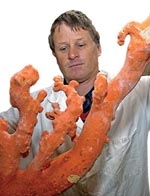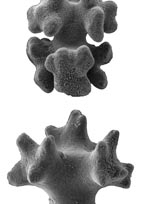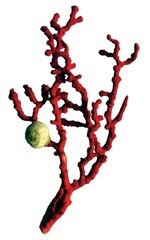PDF of this article (324 KB)

In his study of the octocorals in NIWA’s National Invertebrate Collection, Juan Sánchez has identified eight new species of bubblegum corals, representing half the known species now recognised in the family Paragorgiidae worldwide.
Bubblegum corals are octocorals belonging to the phylum Cnidaria, which also includes stony corals and jellyfish. They form colonies that feed on plankton and drifting organic particles, and have two types of polyp: large polyps with eight tentacles (autozooids) that are usually concentrated in dispersed clusters, and numerous tiny reproductive polyps without tentacles (siphonozooids) that are distributed throughout the colony surface. ‘Bubblegum’ alludes to the distinctive colour and surface appearance of the colony.
Forests of the deep



These branching corals include the largest seafloor organism on the planet, Paragorgia arborea (pictured right), which is found in all major oceans and in our EEZ. They live on continental shelves, slopes, and seamounts (where most fisheries occur), and they provide habitat for many fish and invertebrates. For instance, in the North Atlantic a mere seven colonies of P. arborea were found to harbour over 1300 individuals of 16 species of crustaceans. Disruption of fragile seabed habitats by fishing activities like trawling is endangering these important habitat-formers and associated fishery resources.
Unfortunately, some of the largest octocorals are yet to be studied, so there is no proper account of their diversity or appropriate plan for their conservation. Describing important, long-lived, habitat-forming species like the bubblegum corals is a priority. Owing to the complexity of octocoral taxonomy, particularly in the Paragorgiidae, we have had to compare the New Zealand fauna with all described species worldwide and with samples from other areas of the Pacific in order to validate the numerous new species.
Bubblegum corals are unusual among octocorals. Despite forming enormous tree-like structures, the trunk and branches are not corneous or calcareous like most branching octocorals. Instead, the bubblegum coral’s branches are rigid thanks to the accumulation and near fusion of microscopic sclerites made of calcite, of which there are several forms. Their appearance under the scanning electron microscope (SEM) is distinctive, and this, plus other features, has let us identify new species.
Drawing up the family tree
The NIWA study included all known members of the Paragorgiidae family. Previously, the family comprised only five known species of Paragorgia and one of Sibogagorgia. The new study has yielded two new Paragorgia species from the eastern Pacific and, extraordinarily, eight endemic new species from New Zealand – six of Paragorgia and two of Sibogagorgia. We compared our specimens with historic type specimens (the original and first specimens used to describe the species) loaned by the Smithsonian Institution in Washington, the Natural History Museum, London, and the Zoology Museum of Amsterdam. Some of the type specimens we borrowed are more than a century old, collected in the 1800s during the famous Challenger, Siboga, and Investigator expeditions.
Our morphological study has highlighted four major phylogenetic (or genealogical) groupings: the beige bubblegum corals (Sibogagorgia species), the giant bubblegum coral (Paragorgia arborea), and the remaining Paragorgia species, which comprise two groups. The latter includes a mix of species from the Atlantic and the Pacific, indicating an ancient origin for bubblegum corals. Other studies at NIWA have shown similar divergence for some bubblegum species using DNA sequences, including three of the new species mentioned here.
Hotspots for New Zealand bubblegum corals

The NIWA study has also shown that bubblegum corals exhibit some intriguing geographical patterns unusual for deepwater corals. Paragorgia arborea, for example, has an apparently cosmopolitan but highly discontinuous distribution, occurring in subpolar regions below 200 m and at equatorial latitudes, with no records in-between. Most species have a more restricted distribution. The nine New Zealand species were mostly collected between 800 and 1000 m, suggesting a similar habitat requirement for most bubblegum corals found in New Zealand waters. Two of the new species were collected only off the Chatham Islands, where intense fishing takes place.
The diversity of Paragorgiidae species in New Zealand is the highest for any EEZ. This is not entirely surprising given that New Zealand is a biodiversity hotspot for some other sessile colonial organisms (such as bryozoans, hydrocorals, and glass sponges). The same appears to be true for bamboo corals of the subfamily Keratoisidinae (see Water & Atmosphere 12(4): 22–23), since most of the new species discovered were based on a few specimens.
New Zealand’s octocorals are the poorest-known of any group of large animals in our EEZ. Within the NIWA National Invertebrate Collection alone, a further 195 species await description. We hope that the discovery of so many new species, including the bubblegum corals, will highlight the need for effective conservation strategies in selected deepwater habitats.
Glossary for words in bold
octocorals: corals that have eight tentacles on each polyp.
polyp: an individual in a colony of corals. Polyps are cylindrical and elongated along the body axis. Usually, the polyp is attached at one end and at the other end has a mouth surrounded by tentacles.
corneous: horny.
calcareous: formed of calcium carbonate.
sclerites: microscopic bits of calcium carbonate.
endemic: exclusively native to a place, found nowhere else.
phylogenetic: refers to the tree-like pattern of origin and evolution of a set of organisms, usually species.
cosmopolitan: growing or occurring in many parts of the world, globally distributed.
sessile: describes animals that are permanently attached or fixed in position to a surface.
Snapshot from the family album
Phylum: Cnidaria Class: Anthozoa Subclass: Octocorallia Order: Gorgonacea Family: Paragorgiidae Genus: Sibogagorgia Species: dennisgordoni, tautahi Genus: Paragorgia Species: alisonae, aotearoa, arborea, kaupeka, maunga, wahine, whero
Dr Juan A. Sánchez was a post-doctoral fellow at NIWA and is now an assistant professor at Universidad de los Andes in Colombia. His description of New Zealand bubblegum corals will soon be published in the research journal Zootaxa.
Author contact: [email protected]
Teachers’ resource for NCEA AS: Biology 90462 (2.6), 90717 (3.5) See other curriculum connections at www.niwa.co.nz/pubs/wa/resources
